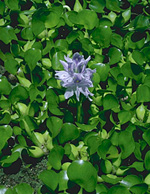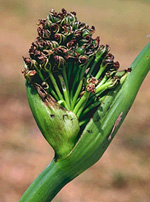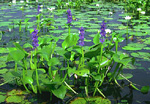 |
This small family of freshwater plants from the tropics of both the Old and New Worlds is represented in Australia by a few native and introduced species, mostly from the tropical north. It includes Eichornia crassipes, one of the world's most serious aquatic weeds.
Characteristic features of the family Pontederiaceae in Australia include: - aquatic herbs, floating (Eichornia) or rooted in the bottom mud, in both cases with erect, emergent, parallel-veined leaves with an ovate blade and long petiole
- flowers showy, usually purplish, blue, violet or mauve, rarely white, in spikes, racemes or panicles, with 6 petal-like, free or fused perianth segments, sometimes slightly zygomorphic, with 6 stamens
- ovary superior, 1- or 3-celled and developing into a capsule
Description
Perennial aquatic herbs, free-floating at or below the water surface or rooted in the substrate with their leaves floating or emergent. Perennating by rhizomes. Vegetative reproduction by rhizomes or stolons. Internal secretions not obvious. Plants glabrous, or with simple, glandular or non-glandular, uniseriate hairs. Leaves alternate and spiral, or distichous, cauline or all or mostly basal, petiolate. Stipule-like lobes absent. Lamina simple, symmetric, lanceolate, ovate or orbicular; base rounded, cordate or hastate or sagittate; margins entire, ±flat; venation parallel, with the midrib inconspicuous, and the tertiary venation not reticulate; surfaces not punctate; herbaceous or leathery. Leaf ligule absent. All the flowers bisexual. Inflorescences terminal, consisting of spikes, racemes or panicles. Bracts present. Pollination by insects. Flowers odourless, sessile or stalked. Perianth regular or irregular, of 2 ±similar whorls, with 6 free or fused petaloid segments, imbricate, crumpled or plicate, tubular, 2-lipped or with palate, white or magenta, purple, violet or blue, without contrasting markings, or streaked, spotted, etc, membranous; claws absent; lobes ±entire. Fertile stamens 6, opposite to and at least partly fused to the perianth segments, free of the ovary and style, distinct from each other or fused by their filaments into an open or closed tube, all ±equal. Anthers dorsifixed or basifixed, versatile or not versatile, opening by pores or by longitudinal slits, 2-celled; appendages absent or lateral. Ovary superior and sessile. Carpels 3, fused; ovary with 1 or 3 locules. Style terminal, single and unbranched or single and branched above. Ovules 1 or numerous per locule, stalked; placentation apical or axile. Fruit a dry, irregular or loculicidal dehiscent capsule, or an indehiscent nut; the perianth on the maturing fruit dry and persistent. Disseminule macro-surface costate; micro-surface ±smooth, brown, grey or black. Seeds 1 or numerous per fruit. Aril absent. Cotyledons 1. Embryo straight.
(Note: this description has been generated from the coded data compiled for the key. Any errors in the key data will be reflected in the descriptions.)
A treatment of the family Pontederiaceae has been published in:
Flora of Australia 45: 46-55.
Australian genera of Pontederiaceae (as recognised for the Flora of Australia)
* = all species introduced
*Eichhornia
Monochoria
*Pontederia

|
  |

Eichornia crassipes (flowering plant)
Photo: M.Fagg © ANBG

Eichornia crassipes (habit)
Photo: M.Fagg © ANBG

Monochoria (fruits)
Photo: S.Jacobs © S.Jacobs

Monochoria australasica (flowering plant)
Photo: S.Jacobs © S.Jacobs

|
 |
|